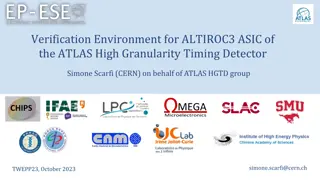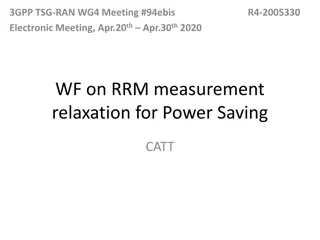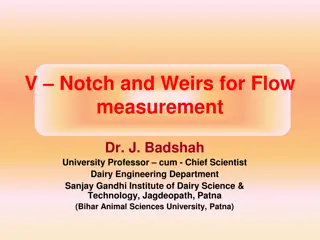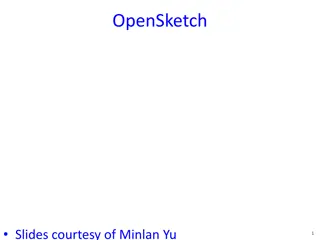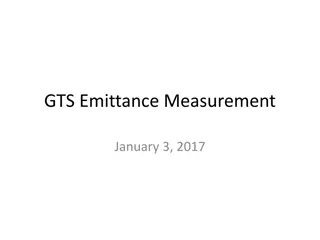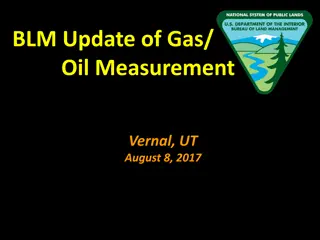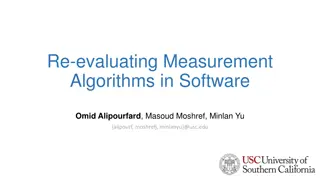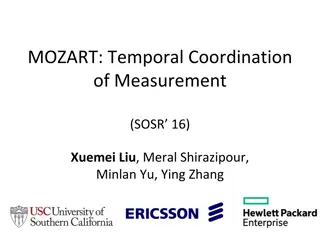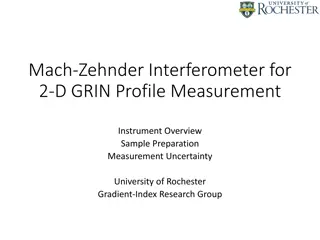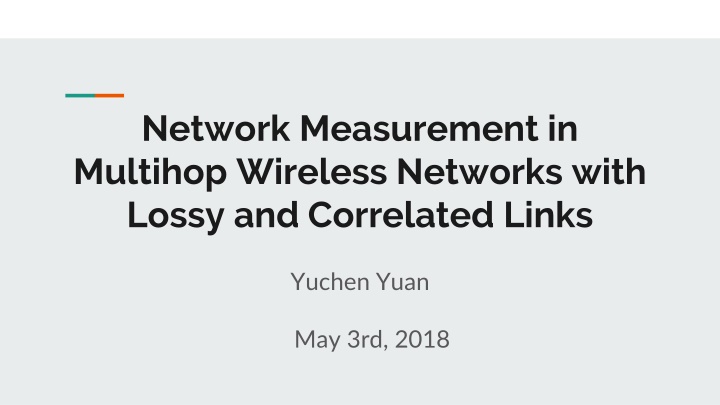
Network Measurement in Multihop Wireless Networks with Lossy and Correlated Links
Explore the challenges and approaches for network measurement in multihop wireless networks with lossy and correlated links. Learn about in-band and out-of-band measurement methods, packet capture ratio, sensor node selection, and system implementation. Discover the motivation behind the need for specialized measurement systems in this network environment.
Download Presentation

Please find below an Image/Link to download the presentation.
The content on the website is provided AS IS for your information and personal use only. It may not be sold, licensed, or shared on other websites without obtaining consent from the author. If you encounter any issues during the download, it is possible that the publisher has removed the file from their server.
You are allowed to download the files provided on this website for personal or commercial use, subject to the condition that they are used lawfully. All files are the property of their respective owners.
The content on the website is provided AS IS for your information and personal use only. It may not be sold, licensed, or shared on other websites without obtaining consent from the author.
E N D
Presentation Transcript
Network Measurement in Multihop Wireless Networks with Lossy and Correlated Links Yuchen Yuan May 3rd, 2018
Introduction & Related Work Outline Motivation NetVision Evaluation
Multihop Networking Multihop V.S. Singlehop
IETF RoLL proposed RPL - multihop routing protocol built on IPv6 for low- power and lossy networks. Related Work WirelessHART -multihop routing protocol with real-time and high- reliability guarantees. Multihop Bluetooth SIG released Bluetooth 5.0 with multihop mesh networking capabilities.
Measurements In-band measurement - collect the measurement data on the same communication channel for data packets, in-band approaches are vulnerable to possible packet losses. Out-of-band measurement - use external sniffers to monitor the network traffic passively. Compared with in-band approaches, they can provide more detailed information about the network
Out-of-band Measurement Packet Capture Ratio(PCR) for each node : the ratio of packets captured (received) by the sniffers among all packets transmitted. Packet capture ratio directly relates to measurement quality. There is always a tradeoff between the number of deployed sniffers (deployment cost) and the packet capture ratio (measurement quality)
SMSN selects sensor nodes from the network and activates sleeping nodes as monitors. Related Work DMWSN deploys external sniffers at arbitrary locations to ensure that every communication link is monitored. Sniffer Deployment
Motivation Existing approaches are unsuitable for multihop wireless networks with lossy and correlated links which is shown by recent studies.
Motivation Most existing approaches are based on the too ideal unit disk graph (UDG) model.
NetVision A practical network measurement system with special considerations for sniffer deployment. NetVision can accurately quantify the packet capture ratio of each node for a given sniffer deployment. Formulated the sniffer deployment problem as an optimization problem and proposed efficient heuristic algorithms for this problem. NetVision provides a set of instructions and APIs to simplify a variety of measurement tasks.
NetVision-Advantages Deployment efficiency While the packet capture ratio for each node satisfying, NetVision should minimize the number of sniffers. NetVision deploys sniffers at node positions in the network without assuming the UDG model. Ease of measurement NetVision makes measurement programming easier by carefully designing a set of simple instructions and APIs.
NetVision-PC side Selects positions to place sniffers to minimize deployment cost and satisfymonitoring requirements NetVision APIs on the sniffer allow the user to specify the type of packets they want to monitor. Trace merging component merges multiple sniffer traces with the correct transmission information and synchronized timestamps.
NetVision-Sniffer Deployment Assumption : assume that sniffers are deployed at the positions of network nodes. This assumption also allows us to use the network nodes as sniffers directly. Definition1 (Packet Capture Ratio): PCR of a node is the percentage of its packets observed by sniffers in S. These packets are either originated or forwarded by the node. Definition2 (Minimum- -covered): A node is minimum- -covered if the packet capture ratio of the node is no less than a specified threshold . The network is minimum- -covered if all nodes are minimum- -covered.
NetVision-Sniffer Deployment Aim at deploying a set of sniffers that: (1) the number of sniffers is minimized (2)the network is minimum- -covered Sniffer Deployment Link-quality-aware sniffer deployment(assume the links are independent , quality of each link is known) Link-correlation-aware sniffer deployment(assume that the links are correlated, link correlations can be obtained)
Set =0.8 For sniffer sets of size 2, the node PCR of v with sniffer set ??,?? is 1 Pr(E v,s i ,E v,s j ). With sniffer set {?1, ?2}, Pr(E v,s 1 ,E v,s 2 ) equals 0.3 from the packet reception trace. Therefore, the PCR of v is 0.7. Similarly, the PCR of v with ?2,?3 and {s 1 ,s 3 } are 0.8. Under link correlation model. The PCR of v with sniffer set ??,?? is the probability that at least one of them observes the packet. With sniffer set {?1, ?2}, PCR of v is 1 (1 0.5) (1 0.6) = 0.8 . PCR of v with set ?2,?3 = 0.76 , with set ?1,?3 = 0.7 Under link independence model.
Link-Quality-Aware Sniffer Deployment In the link independence model, the packet missed by a sniffer has no relationship with the packet missed by other sniffers. Then, the PCR of node v C ? = 1 ?? ??(1 ??,??) ??denotes set of sniffers deployed in node v s neighborhood ??,??denotes packet delivery ratio from node v to sniffer ?? ?? To make sure PCR is no less than k, which is ? ? ?, and packet delivery ratio ??,?of each link ?,? ? , ??be the binary indicator of whether the ?? node is selected as a sniffer node ?, ???? selected ???? ??= ?,
Link-Quality-Aware Sniffer Deployment To find min 1 ? ???S.t ? 1 (1 ??,? ??) ? ?=0 For ??= 0 ?? ??= 1 Our goal is to find the values of ??to minimize the number of sniffers.
Link-correlation-aware sniffer deployment This model s difference is the computation of node PCR. The probability that at least one sniffer in ?? receives the packet from v is calculated as: |??|( 1)? 1Pr(??) ??is any sniffer set with size k ( among total |?|?sniffers ) Pr(??) is probability that any k of the |?|?sniffers successfully receive a packet Pr ??= ?? ??Pr(??,?1 ??,??is the event that a packet is successfully received by sniffer ??, and Pr(??,?1,??,?2) is the probability that both s1 and s2 received the packet, which can be get from packet reception traces as shown in Fig. 2. The 0 indicates a packet loss and 1 indicates a packet reception ? ? = ?=1 ? ..??,?? ?)
Link-correlation-aware sniffer deployment Given the input routing topology G = (V,E) with n nodes, the PCR threshold , and the packet delivery ratio ??,?of each link (u,v) E, the link correlation information among links, this problem could be
Practical Issue For Implementation NetVision needs the help of in-band techniques to obtain the link qualities and link correlations Practical sniffer deployment. the sniffer can be deployed as software. For example, the node can enable the promiscuous mode to monitor the traffic of its neighbors without affecting its regular data traffic. The second way is to deploy external nodes as sniffers Trace recording NetVision collects packet transmission information from its header at each hop and the arrival time. To further reduce the trace size, NetVision enables the user to specify packet types of interest Trace collection A simple way of retrieving traces is via the serial connection. However, it is only possible in an indoor testbed. In outdoor deployment, most sniffers may not be easily accessible. Trace inference. Knowledge of link quality and link correlation
Applications-NetVision Instructions The final goal is to facilitate easy measurement. NetVision provides simple instructions that can support various measurement or debugging applications. TRACE, CFIND, CEXEC
Measurement Applications Hotspots analysis Consider the demand of monitoring node hotspots within the network which is a basic need for network monitoring. Hotspots can cause congestions or packet losses. Thus, it is important to localize hotspots for network monitoring or diagnose NetVision can provide fine-grained per-packet per-hoptransmission visibility inside the network. With a merged fine-grained trace, we can find nodeIDs which appear more than the threshold (e.g., 2000) in a given time range (i.e., tRange).
Measurement Applications Link loss ratio measurement A wireless link is usually characterized by its loss ratio Existing works usually infer the link loss ratio based on network tomography approaches which target at static or slowly changing routing paths and are not suitable for dynamic wireless networks NetVision can measure the link loss ratio accurately based on the actual packet transmissions even in poor network condition
Measurement Applications Packet loss localization Using NetVision, we can observe the packet transmissions from multiple vantage points in the network and reconstruct the trajectory of each packet.
Evaluation simulated 225-node network compare the measurement accuracy in terms of RMSE
Conclusion First to formally consider the sniffer deployment problem in multihop wireless networks with lossy and correlated links. Quantify the measurement quality using a metric called packet capture ratio. Based on this metric, we formulate the sniffer deployment problem as an optimization problem and propose efficient heuristic algorithms to address it. Designing and implementing NetVision, a practical net-work measurement system in TinyOS/TelosB platform. NetVision exposes a set of APIs to facilitate a varietyof measurement tasks. Applying NetVision in three case studies demonstrates its benefits over existing in-bandmeasurement approaches.

